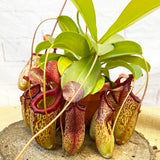25 cm Syngonium Red Spot House Plant 14 cm Pot
Syngonium Red Spot, also known as Arrowhead Vine or Goosefoot Plant, is a popular houseplant known for its attractive foliage. It belongs to the Araceae family and is native to tropical regions of Central and South America. The plant gets its name from the arrowhead-shaped leaves and distinct red spots or blotches that develop as it matures. Syngonium Red Spot is relatively easy to care for, making it a great choice for both beginners and experienced plant enthusiasts.
Light: Syngonium Red Spot thrives in bright, indirect light. It can tolerate low light conditions but may lose its vibrant leaf coloration. Avoid placing the plant in direct sunlight as it can scorch the leaves. A north or east-facing window is ideal for this plant.
Temperature: This plant prefers temperatures between 65¬?F to 85¬?F (18¬?C to 29¬?C). It can tolerate slightly lower temperatures but is sensitive to cold drafts. Avoid placing it near air conditioning vents or open windows during colder months.
Humidity: Syngonium Red Spot appreciates a relatively humid environment. Mist the leaves regularly or use a humidifier to increase humidity levels, especially in dry indoor environments. Placing the pot on a tray filled with water and pebbles can also help maintain higher humidity.
Watering: The soil should be kept consistently moist but not waterlogged. Water the plant thoroughly when the top inch (2.5 cm) of soil feels dry. Ensure good drainage by using a well-draining potting mix. Overwatering can lead to root rot, while underwatering can cause leaf wilting and browning.
Fertilizer: Feed Syngonium Red Spot with a balanced liquid fertilizer diluted to half strength every two to four weeks during the growing season (spring and summer). Reduce the frequency to once a month during fall and winter. Avoid over-fertilizing, as it can lead to leaf burn.
Pruning: Regular pruning helps maintain a compact and bushy shape. Trim back overgrown or leggy stems to encourage new growth. You can also pinch off the tips of the plant to promote branching. Wearing gloves is recommended, as the sap of Syngonium plants can cause skin irritation.
Propagation: Propagating Syngonium Red Spot is relatively easy and can be done through stem cuttings. Take a 4-6 inch (10-15 cm) cutting with at least two nodes and remove the lower leaves. Place the cutting in a jar of water or a well-draining potting mix until roots develop. Once rooted, transfer the cutting to a pot with appropriate potting soil.
Pests and Diseases: Syngonium Red Spot is generally resistant to pests, but it can occasionally be affected by common houseplant pests such as spider mites, aphids, and mealybugs. Regularly inspect the plant for any signs of infestation and treat immediately with organic insecticidal soap or neem oil.
In conclusion, Syngonium Red Spot is a beautiful and relatively low-maintenance houseplant that can add a touch of tropical beauty to any indoor space. With proper care, it will reward you with lush foliage and striking red spots, making it a delightful addition to your plant collection.
Check out our YouTube video to see exactly how we pack for safe delivery.
- Plants are supplied in plastic nursery pots unless stated in the product title.
- Plants are not for consumption unless stated as edible.
- Plant heights can fluctuate +/- 10%.
- Our plants are kept at our tropical nursery in Yorkshire where we maintain an average temperature of 18c.
































